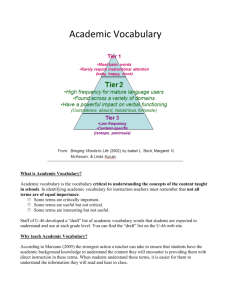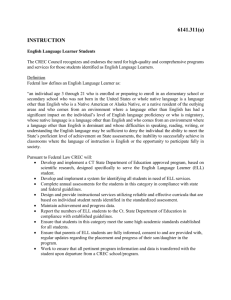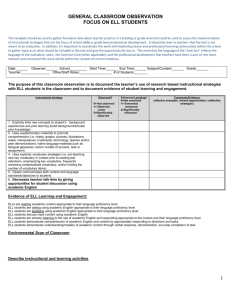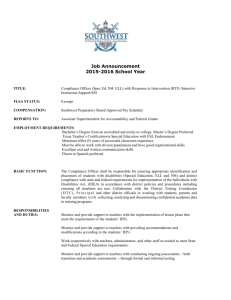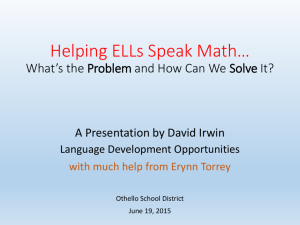SDAIE Strategies:
advertisement
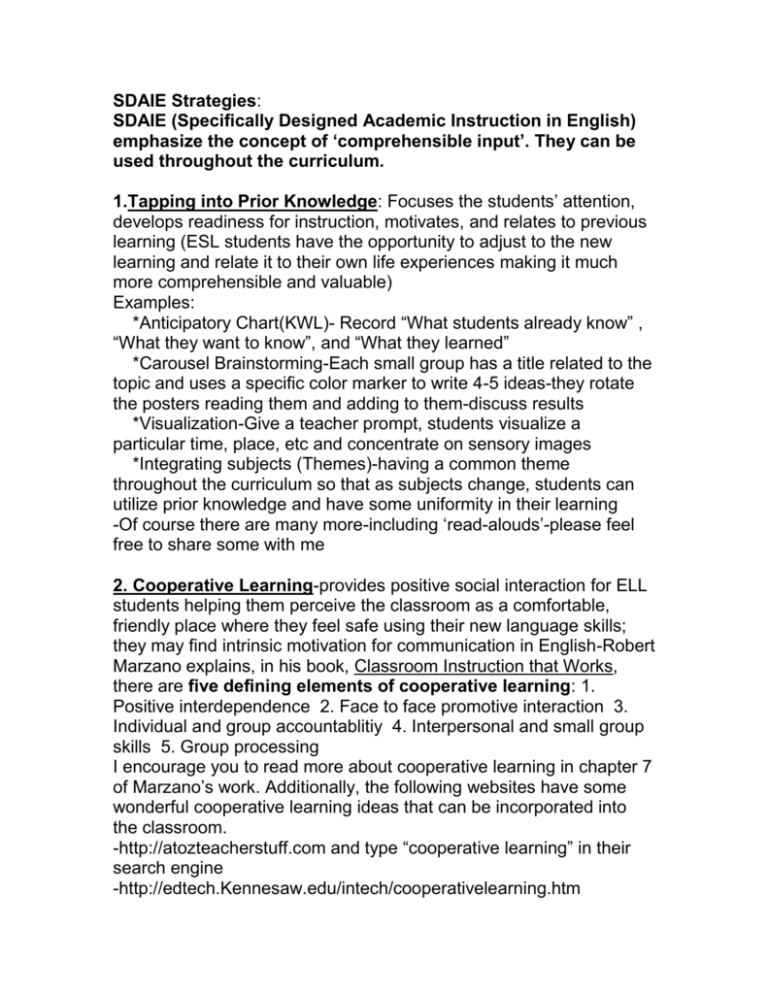
SDAIE Strategies: SDAIE (Specifically Designed Academic Instruction in English) emphasize the concept of ‘comprehensible input’. They can be used throughout the curriculum. 1.Tapping into Prior Knowledge: Focuses the students’ attention, develops readiness for instruction, motivates, and relates to previous learning (ESL students have the opportunity to adjust to the new learning and relate it to their own life experiences making it much more comprehensible and valuable) Examples: *Anticipatory Chart(KWL)- Record “What students already know” , “What they want to know”, and “What they learned” *Carousel Brainstorming-Each small group has a title related to the topic and uses a specific color marker to write 4-5 ideas-they rotate the posters reading them and adding to them-discuss results *Visualization-Give a teacher prompt, students visualize a particular time, place, etc and concentrate on sensory images *Integrating subjects (Themes)-having a common theme throughout the curriculum so that as subjects change, students can utilize prior knowledge and have some uniformity in their learning -Of course there are many more-including ‘read-alouds’-please feel free to share some with me 2. Cooperative Learning-provides positive social interaction for ELL students helping them perceive the classroom as a comfortable, friendly place where they feel safe using their new language skills; they may find intrinsic motivation for communication in English-Robert Marzano explains, in his book, Classroom Instruction that Works, there are five defining elements of cooperative learning: 1. Positive interdependence 2. Face to face promotive interaction 3. Individual and group accountablitiy 4. Interpersonal and small group skills 5. Group processing I encourage you to read more about cooperative learning in chapter 7 of Marzano’s work. Additionally, the following websites have some wonderful cooperative learning ideas that can be incorporated into the classroom. -http://atozteacherstuff.com and type “cooperative learning” in their search engine -http://edtech.Kennesaw.edu/intech/cooperativelearning.htm 3. Nonlinguistic Representations: Written and oral words often need situational and contextual help in order to be understood. Marzano discusses in his work, Classroom Instruction That Works, that knowledge is stored in two forms ‘linguistic form’ and ‘imagery form (nonlinguistic)’. He discusses, in chapter 6, that the more both forms are used, the better students are able to think about and recall knowledge. The ‘imagery form’ is crucial to making content comprehensible to ELL students. Below, are some ideas of how to incorporate nonlinguistic representations into the curriculum: Demonstrate; use manipulatives: Whenever possible, accompany your message with gestures, pictures and objects that help get the meaning across. Use a variety of different pictures or objects for the same idea. MODEL, MODEL, MODEL Focus on vocabulary: Pre-teach vocabulary and concepts; use realia, demonstrations, visuals, and multiple modalities when teaching. Illustrate, label, explain multiple meaning words. Graphic Organizers: Marzano has some great ideas in regards to using graphic organizers. Beginning English speakers can create graphic organizers using only pictures while intermediate and advanced ELL students can combine pictures with words and/or phrases. 4. Reduction of Teacher Talk –this strategy can be, and usually is, interpreted in two different ways: 1.The teacher tries to incorporate the students and the use of their oral language in the lesson as much as possible-the students can volunteer and share information on the concept/subject, cooperative groups/think-pair share, just utilizing ways the students can be part of the lesson so as to reduce the teacher language that ELL students can not always follow due to the unknown vocabulary. Providing the information at the teacher level and at the student level allows for the information to be more comprehensible to the ELL students. 2. Another way this is interpreted is that the teacher presents what is really “ESSENTIAL” in the lesson. What vocabulary is necessary to introduce in order for them to understand the concept being taught? This allows for extraneous information to be removed and shared at a later time when students have grasped the basic concepts and are ready for extensions. (Please do not think that I am saying “dumb down” or “water down” the information, which is sometimes how theis strategy is misconstrued) It simply means to pull out the essentials and also try to use some of the other “nonlinguistic representations” discussed in the past purple paper. Remember –“a picture can tell a 1000 words” 5. Multicultural Education- promoting and utilizing each student’s individuality and culture into their educational environment-incorporated into the classroom on a daily basis by embracing similarities and differences in your students, utilizing their backgrounds into your instruction, and enabling them to be learners of other cultures and teachers of their own. I am not speaking of times when certain rituals or foods are shared one day a year from a different culture--an everyday, ongoing strategy---a student’s cultural background viewed as positive and essential in developing classroom instruction and a welcoming school environment—It is important to see students as individuals whose school behavior is influenced by family, community, and ethnocultural groups of which they are a part-- In order to treat each student respectfully as individuals and expect students to treat each other respectfully, we must learn about the relevant social and cultural groups in their lives. Growing up in a community whose schools populations were 12-15% white and a completely diverse 85%, it was very empowering to have the teacher incorporate small pieces of who we all were and allow us to share a. piece of ourselves. The community feeling is one that is important to create for ELL Learners (reduces anxiety—lowers the affective filter). Activities: Culture Bag: students bring from home a few items that represent who they are as a person; students learn about others--teachers learn about students Similarities and Differences: When comparing other cultures or people; be sure to emphasize wonderful similarities--Multicultural Literature-Excellent web pagewww.dawcl.com Visual/Oral Representations: Students can share, through visual representation or oral, what a certain concept means to them or what background knowledge they have— SDAIE=Multicultural Education Basically---Remember who your audience is when teaching--6. Check for Understanding: This seems basic and you are probably already doing it and that’s great. This allows ELL students to have time to process what the teacher has said, hear it from their peers, and show understanding in a non-verbal way. It also shows the teacher the students’ level of understanding and, therefore, possible re-teaching ideas. If they understand, they will be successful at the task building self confidence. Ideas: (Ask them questions before asking the famous question “do you have any questions” which typically few students respond to, especially ELL students) -Ask ‘yes’ and ‘no’ questions, ‘thumbs up’ or ‘thumbs down’, ‘true’ or false’, or supply multiple choice answers -Have them point to, respond by doing something/acting out, or drawing something -Give them a sentence they have to complete -Let the students retell a lesson/activity in their own words -‘Think-Pair-Share’ the activity or lessons components -Ask the students to order what they will do practicing transition words, “first, next, after, last”, “first, second, third”, etc. -Trick them, throw in funny questions, make ‘checking for understanding’ a game. Remember: before even checking for understanding “Model, Model, Model” 7.Manipulatives-Hands on Experiences-ELL students need the tactile-kinesthetic experiences with physical objects, experiences that are fundamental in linking words with the objects/pictures. Students can visually and physically manipulate objects that are directly linked with the concepts being taught. This allows them to understand the concept in a way that is more accessible and understandable than with words. Additionally, as Marzano states in his work, Classroom Instruction that Works, “using manipulatives generates a concrete representation, an ‘image’ of the knowledge in students’ minds”. The teacher, therefore, is aware of what the student understands without them expressing it in words. It is important to allow them to use the manipulatives until they are ready to give them up. By doing that, you are allowing them to fully understand the concept and then break away from the manipulatives when they can understand it linguistically. All subjects can entail manipulatives: -math (foundational to understanding numbers), science, language arts (cut and organize ideas in words strips, use different tactile experiences to introduce vocab/spelling words/concepts, tableau, pantomime-a-tale), -drawings, posters, brainstorming-clusters, graphs, tables, maps, props, multimedia presentations, storyboards, storymaps Please share some ideas with me

